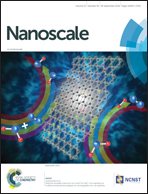Ultrafine Mo-doped SnO2 nanostructure and derivative Mo-doped Sn/C nanofibers for high-performance lithium-ion batteries†
Abstract
Tin-based materials have been intensively studied as attractive candidates for high-capacity and long-cycle-life anodes in Li-ion batteries (LIBs) owing to their low cost and high energy density. However, they all suffer from severe structural decay during the lithium ion insertion/extraction process, which results in deterioration in the overall performance of the batteries. To mitigate this problem, we have synthesized a Mo-doped SnO2 nanostructure via a facile hydrothermal method, which then fragmented into ultrafine particles after dozens of cycles. The fracture-resistant size and ample contact with Super-P and Li2O greatly improved the electrochemical kinetics and cyclability to deliver a reversible capacity of 670 mA h g−1 after 700 cycles, which demonstrated the potential suitability of Mo-doped SnO2 nanoparticles as a long-cycle-life anode material. Then, the compounds were uniformly dispersed in carbon nanofibers and reduced in situ to prepare a free-standing anode via electrospinning and carbonization. When used directly as an anode in LIBs (without a polymeric binder or conductive agent, as well as a current collector), the nanofiber membrane anode delivered comparable cycling performance and capacity to that of a slurry-coated electrode.



 Please wait while we load your content...
Please wait while we load your content...